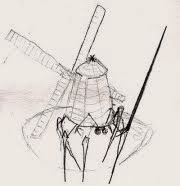
I've been experimenting with cranks to avoid slides and/or linear bearings.
The first one looked promising. The key is the ratio between crank lengths. While Lego only allows integer spacing, I was still able to find a arrangement that gave me five inches of travel with less than 0.5mm eccentricity. 14 base : 8 head : 20 arm or 1 : 0.5714287 :1.42857.
I honestly don't know if the repeating decimals are significant or co-incidental.

Mounting two of these assemblies would give an X-Y arm.
Rigid, simple, and not needing accurately straight edged material.
I was pretty pleased.
I played with for a while before I realized the problem: while the arm's tip stayed in plane, its attitude changed. So my attitude changed as well.

The simplest way to keep the printhead oriented vertically would be to use gravity and a damn heavy plumb bob - which would stress the mechanism and play hob with dynamic forces.
A servo could be equipped - or another crankarm - to keep the printhead vertical, but that just seems to add complexity, and destroy the elegance.
On to system two:

This one also looked pretty good until it didn't.
It was'nt until I was fitting the leadscrews that I discovered the problem: that to traverse X requires a Y servo change as well, and vis versa. this leads into the same kind of annoying inverse kinematic problems I'd rather avoid.

Because if I'm going to use inverse kinematics to any extent, I might as well just build a reasonably DOF robot arm, and use it to hold a printhead in its hand.


No comments:
Post a Comment